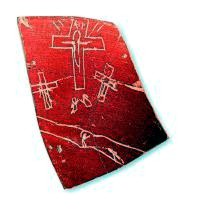
 |
Freethought & Rationalism ArchiveThe archives are read only. |
|
|||||||
|
|
Thread Tools | Search this Thread |
|
|
#1 |
|
Veteran Member
Join Date: Nov 2007
Location: Chicago, IL
Posts: 3,058
|
With thanks to David Meadows and others:
http://terraeantiqvae.blogia.com/200...historia-d.php Note the photo of the ostraca -- from a Roman backwater no less (Iru�ea Veleia)! -- that bears a Calvary scene. Jeffrey |
|
|
|
|
#2 | |
|
Contributor
Join Date: Jun 2000
Location: Los Angeles area
Posts: 40,549
|
Here's a google translation of the Spanish:
Quote:
|
|
|
|
|
|
#3 |
|
Veteran Member
Join Date: Jun 2005
Location: Maryland
Posts: 1,402
|
If this is the Calvary scene:
 I count more than three crosses, and since crucifixion was fairly common in the Empire, how do we know that the depicted scene is supposed to be Calvary? |
|
|
|
|
#4 | |
|
Contributor
Join Date: Jun 2000
Location: Los Angeles area
Posts: 40,549
|
There is a wikipedia entry that describes this find.
Quote:
http://veleia.com/english/index.php There is an upcoming international conference |
|
|
|
|
|
#5 | |
|
Veteran Member
Join Date: May 2005
Location: Midwest
Posts: 4,787
|
Quote:
 Note the two figures in front of the center cross. Ben. |
|
|
|
|
|
#6 | ||
|
Veteran Member
Join Date: Nov 2007
Location: Chicago, IL
Posts: 3,058
|
Quote:
But of course, it's a Eusebian forgery! Jeffrey Jeffrey |
||
|
|
|
|
#7 | ||
|
Veteran Member
Join Date: May 2005
Location: Midwest
Posts: 4,787
|
Quote:
Quote:
 Ben. |
||
|
|
|
|
#8 |
|
Contributor
Join Date: Jun 2000
Location: Los Angeles area
Posts: 40,549
|
It would be interesting to have an artifact that can be carbon dated to the 3rd century, and it would surely put an end to Pete's speculation about the invention of Christianity in the 4th century (a consummation devoutly to be wished, by this moderator, anyway.)
But there is a lot of stuff in this archeological find that is just too suited for important political constituencies, or just puzzling. Egytpian hieroglyphics - when the Egyptians had started to write Coptic with the Greek alphabet? Basque language written in Latin alphabet - earlier than any other examples by 8 centuries? The first representation of the crucifixion? There's an article here in English. |
|
|
|
|
#9 |
|
Veteran Member
Join Date: Apr 2004
Location: London, UK
Posts: 3,210
|
|
|
|
|
|
#10 |
|
Veteran Member
Join Date: Oct 2004
Location: Bordeaux France
Posts: 2,796
|
The titulus is RIP, clearly to be seen on a picture, lower on the page.
|
|
|
| Thread Tools | Search this Thread |
|